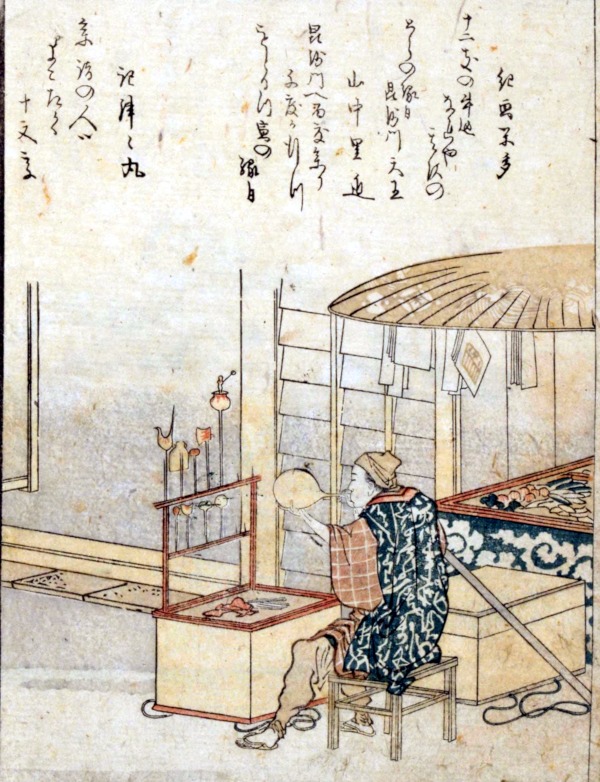It is amazing that there was a person who first thought of using scissors to shape "candy" which is written "eat and be pleased" in Japanese Kanji.
When did the term "Amezaiku" or everyone's image of "crafting into various shapes such as animals using Japanese scissors" originate and take root?
Traditional Japanese Amezaiku began at some point in time to be called "Ame no Tori" (bird-shaped-candy), and in the past it was still widely known as "Ame no Tori" rather than "Amezaiku.

It was in 1746 (Enkyo 3) that the story of an candy seller was performed in joruri (a type of dramatic recitation): "Now, now, children, buy, buy, buy, buy… Ame no tori, ame no tori…" The first time the story was read in a senryu poem was in 1800 (Kansei 12). In the old days, the shape of a bird was used exclusively. The term "Amezaiku" gradually came to be used, but until the beginning of the Showa era (1853), "Ame-no-tori" was still used in some regions.
So when did this "Ame no tori" start? It was in the mid-Edo period…
The candy, which was very precious before that time, began to be produced domestically, and the current form was probably created during the Bunka-Bunsei period, when life in Edo was peaceful.It was called "Ame no tori" at that time, and unlike other candy sellers (such as "To-jin ame sellers" who did not work on the candy), it seems that at least the style of "crafting the candy into the shape of animals and other objects" had begun.

However, it is not certain if it was still called "Amezaiku". Perhaps later it was also called "blown candy". When it comes to "blown candy," it is quite distinct from ordinary confectionary candy. The term "blown candy" is still used by some. The term "Amezaiku" began to be used in place of this "blown candy" and has become a very common term. Therefore, the style of "candy crafted into the shape of mainly animals and other objects using Japanese scissors" must have emerged at some point, and the terminology has changed over time and from region to region.
Use of Japanese scissors and expansion of Amezaiku
In the early Edo period (1603-1868), there were amezaiku craftsmen who made various types of candies such as Chitose-ame, but the appearance of amezaiku craftsmen required, above all, Japanese scissors. The mass production of Japanese scissors is thought to have started after the mid-Edo period, when the "tatara iron manufacturing method" was established with the invention of the balance bellows and iron production increased dramatically. So, roughly speaking, it has been 300 years since the current style was introduced. (*If you want to consider ordinary candy, such as twist candy, as "Amezaiku" in a broader sense, we call it "Amezaiku" here, which means "crafting candy into the shape of mainly animals using Japanese scissors".)

In the old days, a candy craftsman was recognized as a full-fledged artisan when he was able to turn all of the two 18-litre can of mizuame into candy for sale in a single day. It was very hard work to boil the syrup from early in the morning over a fire, cool it down, and knead it before it was completely cooled down again, and finally finish it into small candy balls or other small products. As they grew older and eventually became unable to do this hard work, they sold Amezaiku, a craft of candy made with a variety of shapes, throughout the city. (This painting depicts Yokohama in the early Meiji period.) It is because the craftsmen knew all about candy as materal, including its properties, that they were able to create this type of candy work.

In the old days, as shown in this painting, candy was attached to the tips of reeds, which were then inflated to make mainly birds and other objects. Old postwar photos also show that they were making birds and other animals. Also, as seen in this painting, the candy was especially popular among children, who eagerly watched as the various shapes of candy were created, a scene that has remained exactly the same throughout the ages as it is today. Amezaiku is now nostalgic for adults, but it is funny because elementary school students also say things like "I feel it nostalgic".

